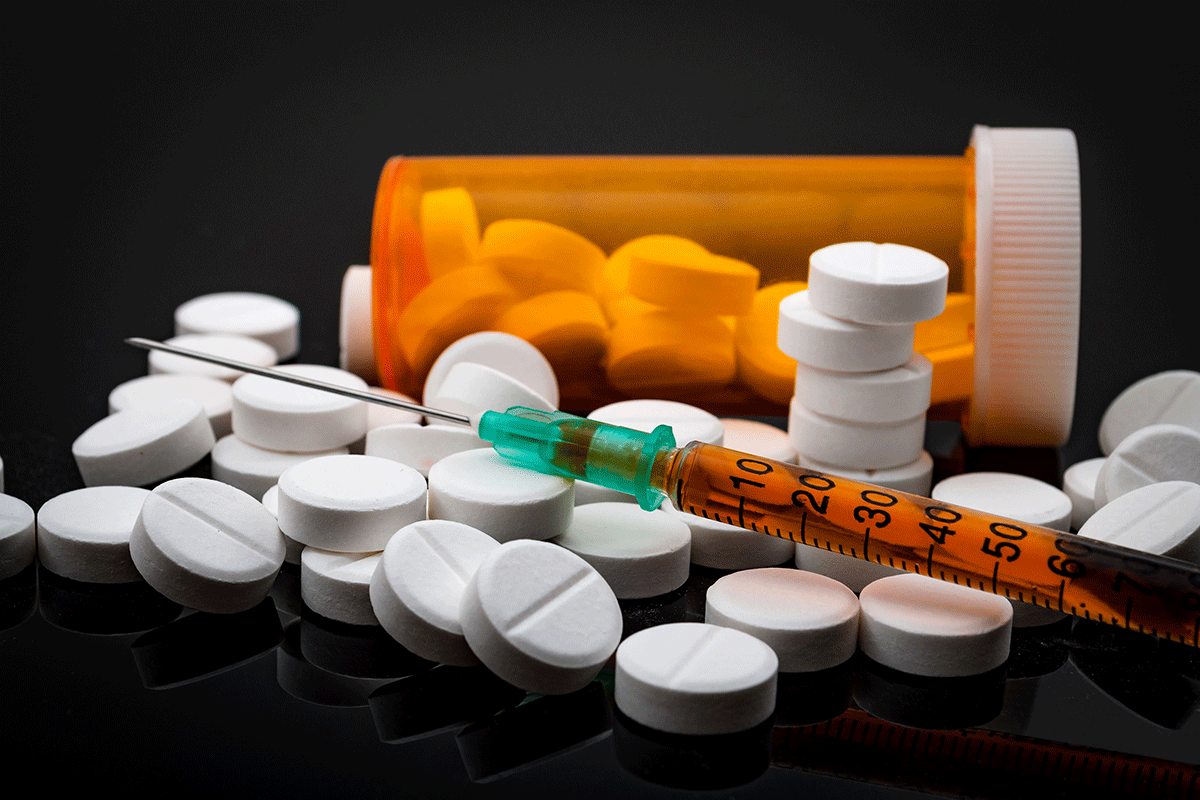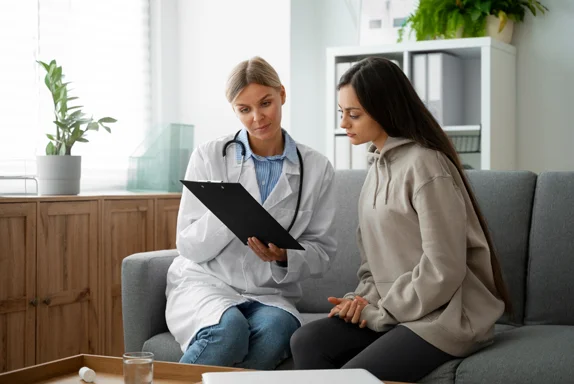Opioid addiction is a chronic and relapsing disease that can affect anyone. However, recovery is possible with the right treatment approach. Before knowing the treatment it is important to understand how the addiction is developed.
Opioids are a class of pain-relieving medications prescribed by doctors to treat severe and persistent pain.
The chemical composition of opioids consists of a benzene ring with a phenolic hydroxyl group, an alcohol hydroxyl group, and a nitrogen atom attached to it. The natural endorphins produced by our body to relieve pain have a similar structure to the opioid. Due to the similarity in the structure opioids bind to the same receptors in the brain like endorphins to relieve pain. Endorphins have various other health benefits apart from pain relief like improved sleep quality, enhanced immune system function, reduced inflammation, and boosted self-esteem. Endorphins reduce your perception of pain while increasing feelings of pleasure, resulting in a brief but powerful sense of well-being.
How does opioid addiction develop?
Opioids are highly addictive, in large part because they activate powerful reward centers in the brain. Opioids are the most effective drug, they hit the brain’s happy spot and help in treating post-surgical pain, cancer pain, or pain during end-of-life care. When opioids are taken repeatedly over time, the production of endorphins in the body slows down. The same dose of opioids no longer produces such a significant flood of happy feelings. This is called tolerance. One reason opioid addiction is so common is that people who develop tolerance may feel the urge to increase their doses so they can keep feeling good.
Nowadays, doctors are really careful about giving more opioids because they know the risks. Sometimes it’s hard to convince them to increase the dose or refill the prescription. So, some people who think they need more end up getting opioids illegally or turning to heroin instead.
Some of the opioids that are available illegally include:
- Heroin: It’s an illegal opioid made from morphine.
- Fentanyl: This is a super strong opioid, sometimes illegally made, and it’s much more powerful than other opioids.
- Oxycodone: It’s a prescription painkiller, but some get it illegally for non-medical use.
- Hydrocodone: Similar to oxycodone, it’s a prescription drug often misused when obtained illegally.
- Methadone: It’s a medication for opioid addiction but can also be abused if obtained unlawfully.
When to seek help with opioid addiction?
It can be difficult to tell if someone is addicted to opioids, but there are some signs to look out for. And educate them to take the necessary opioid treatment facilities.
According to the American Psychiatric Association’s Diagnostic and Statistical Manual of Mental Disorders, Fifth Edition (DSM-5), a person must have experienced at least two of the 11 symptoms within the past year to be diagnosed with substance use disorder.
Here are some common signs of opioid addiction:
- Taking opioids in larger amounts or for longer periods than prescribed.
- failing to reduce or control opioid use.
- Investing a significant amount of time in obtaining, using, or recovering from opioids.
- Cravings or strong urges to use opioids.
- Continuing to use opioids despite negative consequences.
- Giving up important activities because of opioid use.
- Using opioids in situations where it is physically hazardous.
- Developing tolerance to opioids.
- When opioid usage is stopped, withdrawal symptoms occur.
- Using opioids to relieve or avoid withdrawal symptoms.
- Using opioids to achieve a desired effect, such as euphoria
Is opioid addiction treatable?
Yes, opioid use disorder is treatable. According to the National Institute on Drug Abuse, In 2020, an estimated 2.7 million people in the United States aged 12 and above had an opioid use disorder (OUD) in the previous 12 months, including 2.3 million with a prescription opioid use disorder.
There are several opioid treatment facilities to treat patients suffering from withdrawal symptoms and cope with cravings.
- Medical assisted treatment (MAT)
- Counselling
- Support from family and friends
Medications Used in Opioid Recovery Programs
For people suffering, medication is often the best help with opioid addiction. Medication-assisted treatment is a way to help with addiction by using medicine along with counseling and support.
Taking medicine for opioid addiction is like taking medicine for heart disease or diabetes. It’s not about swapping one addiction for another. When used correctly, the medicine doesn’t create a new addiction. It helps manage addiction so that recovery stays on track.
Some of the most common medications used to help with opioid addiction are:
- Methadone: Methadone is a long-acting opioid blocker that acts by attaching to the same brain receptors as heroin, morphine, and oxycodone. It can be orally taken and it is prescribed by only licensed opioid treatment programs, or “methadone clinics.” Methadone reduces withdrawal symptoms and cravings, and it can help patients stay in treatment. Methadone Is taken orally, in liquid form, or as a tablet or wafer. It is often provided via a government-approved program.
- Buprenorphine: Buprenorphine is another partial opioid agonist that works by binding to the same receptors in the brain as other opioids, but it produces weaker effects. It is prescribed by qualified doctors to help with opioid addiction. Suboxone is a medicine usually prescribed by physicians that have: buprenorphine and naloxone. It’s made so people can’t misuse it to feel high. If someone tries to crush, sniff, or inject Suboxone, the naloxone gets released causing withdrawal symptoms.
- Naltrexone: Naltrexone (Vivitrol) is another opioid antagonist that stops opioids from engaging the brain regions where they normally function. In other words, if a person is on naltrexone and consumes an opioid, they will not experience the typical euphoric effects. It can be administered orally or by injection. Naltrexone is effective in providing help with opioid addiction by reducing cravings and preventing relapse.
How does Therapy help in an Opioid Recovery Program?
Several therapies can be used to treat opioid addiction along with the combination of medications.
Cognitive Behavioral Therapy (CBT)
According to the Substance Abuse and Mental Health Services Administration’s (SAMHSA) 2021 National Survey on Drug Use and Health, 9.2 million adults in the United States have co-occurring substance use disorders and other mental health issues.
Cognitive is the most common and effective therapeutical method used for people suffering from opioid addictions along with mental health disorders like anxiety, depression, and trauma. This therapy assists people in identifying and changing harmful mindsets and behaviors that may be contributing to their addiction. CBT can assist individuals in developing coping skills and methods for dealing with cravings and triggers.
Contingency management
Contingency management is used when people with substance issues are required by their job or the court to get treatment. In this system, if they don’t follow the treatment, they might lose their job, go to jail, or have a bad reputation. This therapy gives rewards to people who stay away from using opioids. These rewards can be things like vouchers, prizes, or other treats.
Motivational interviewing
This therapy assists patients in identifying their motivations for changing their behavior. It can help individuals in developing a plan for transformation and increase their motivation to carry out that plan.
Family Therapy
Family therapy involves family members in the treatment process. This therapy is beneficial when someone in the family has an addiction problem, especially if the person is a teenager. It’s not just about the person using drugs, but the whole family works together. It can help improve communication and relationships between family members and provide support for the individual in recovery. Hearing how their loved ones are affected might help the person using drugs to want to change.
What are 12 Step Opioid treatment facilities?
12-step Facilitation Therapy is a form of structured treatment that helps individuals with substance use disorders understand and engage with the 12 steps. The goal of 12-step Facilitation Therapy is to help individuals develop a sense of spirituality and connection to a higher power, which can help them overcome addiction
The 12 steps are a set of guiding principles that were developed by Alcoholics Anonymous (AA) to help individuals overcome addiction. The steps focus on admitting powerlessness over addiction, seeking support, making amends, and maintaining sobriety.
12-step Facilitation Therapy is often used in combination with other therapies, such as cognitive-behavioral therapy (CBT) and medication-assisted treatment. The therapy is effective in treating substance use disorders, particularly alcohol use disorder
How can opioids be used safely to manage pain without becoming addicted to them?
Opioids can help manage pain, but it’s important to use them carefully under a doctor’s guidance to avoid problems.
Anesthesiologists are experts in managing pain and using medications, including opioids. If you’re in pain, they can help find the right treatment to ease your pain and lower the chance of side effects or addiction.
Here are some tips for safely using opioids if your doctor prescribes them:
- Talk to your doctor: Consult your doctor to see if any other pain relievers do not carry the danger of addiction. If you need opioids, ask how to lower the risks and side effects. Tell them about your health history, past opioid use, or any addiction issues.
- Look out for side effects: Some are mild like feeling sleepy or constipated, but others like shallow breathing or loss of consciousness can be serious. Ask your doctor what to watch for and what if there seems to be an opioid overdose.
- Follow instructions: Strictly follow the instructions provided by the medical expert and take the dosage as per the physician.
- Before surgery: If you’re planning surgery and taking opioids, talk to your surgeon and medical team. Long-term opioid use can complicate surgery, so they can help manage your pain safely.
Frequently Asked Questions (FAQ)
What is the most common opioid treatment?
The most common opioid treatment is medication-assisted treatment (MAT). MAT involves the use of medications such as methadone, buprenorphine, and naltrexone to reduce withdrawal symptoms, cravings, and illicit opioid use.
What are the different types of opioid treatments?
There are several types of opioid treatments available. Here are some of the most common ones:
- Medication-assisted treatment (MAT):
- Cognitive-behavioral therapy (CBT)Contingency management
- Motivational interviewing
- Family therapy
- 12-Step Facilitation Therapy
- What is the safest strong painkiller?
Nonsteroidal anti-inflammatory drugs (NSAIDs) such as ibuprofen (Advil, Motrin), naproxen (Aleve), and aspirin are commonly used OTC painkillers. So is acetaminophen (Tylenol).
Conclusion
If you know someone who is addicted to opioids, it is important to encourage them to seek medical help as soon as possible. If your loved one is experiencing any of the signs that are mentioned above, it is important to encourage them to seek medical help. If they are having withdrawal symptoms, overdose symptoms, or other health problems due to opioid usage, they should seek emergency medical attention.
Treatment for opioid addiction can vary depending on the patient’s individual needs and can occur in a variety of settings. Medications such as methadone, buprenorphine, and naltrexone can be effective in reducing withdrawal symptoms, cravings, and illicit opioid use. It is important to note that finding an opioid treatment program may not just improve your loved one’s quality of life but also save them from a deadly overdose.
The best way to get a schedule that outlines what has to be done is to participate in guided treatment programs. At Calusa Recovery, we provide three opioid treatment programs, each customized to meet the individual needs of the patient.
For additional information and to receive a customized treatment plan for your opioid addiction, visit us.










